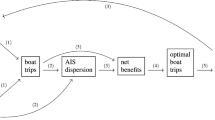Abstract
We consider the model of invasion prevention in a system of lakes that are connected via traffic of recreational boats. It is shown that in presence of an Allee effect, the general optimal control problem can be reduced to a significantly simpler stationary optimization problem of optimal invasion stopping. We consider possible values of model parameters for zebra mussels. The general N-lake control problem has to be solved numerically, and we show a number of typical features of solutions: distribution of control efforts in space and optimal stopping configurations related with the clusters in lake connection structure.
Similar content being viewed by others
References
Bossenbroek, J.M., Kraft, C.E., Nekola, J.C., 2001. Prediction of long-distance dispersal using gravity models: zebra mussel invasion of inland lakes. Ecol. Appl. 11(6), 1778–788.
Brock, W.A., Xepapadeas, A., 2003. Valuing biodiversity from an economic perspective: a unified economic, ecological, and genetic approach. Am. Econ. Rev. 93(5), 1597–614.
Buchan, L.A.J., Padilla, D.K., 1999. Estimating the probability of long-distance overland dispersal of invading aquatic species. Ecol. Appl. 9, 254–65.
Carlson, D.A., Haurie, A.B., Leizarowitz, A., 1991. Infinite Horizon Optimal Control. Springer, Berlin.
Clark, C.W., 1990. Mathematical Bioeconomics. The Optimal Management of Renewable Resources. Wiley, New York.
Courchamp, F., Clutton-Brock, T., Grenfell, B., 1999. Inverse density dependence and the Allee effect. Trends Ecol. Evol. 14(10), 405–10.
Gregory, J., Lin, C., 1992. Constrained Optimization in the Calculus of Variations and Optimal Control Theory. Van Nostrand Reinhold, New York.
Hastings, A., Cuddington, K., Davies, K.F., Dugaw, C.J., Elmendorf, S., Freestone, A., Harrison, S., Holland, M., Lambrinos, J., Malvadkar, U., Melbourne, B.A., Moore, K., Taylor, C., Thomson, D., 2005. The spatial spread of invasions: new developments in theory and evidence. Ecol. Lett. 8, 91–01.
Horvath, T.G., Lamberti, G.A., 1997. Drifting macrophytes as a mechanism for zebra mussel (Dreissena polymorpha) invasion of lake-outlet streams. Am. Midl. Nat. 138, 29–6.
Johnson, L.E., Carlton, J.T., 1996. Post-establishment spread in large-scale invasions: dispersal mechanisms of the zebra mussel dreissena polymorpha. Ecology 77(6), 1686–690.
Johnson, L.E., Riccardi, A., Carlton, J.T., 2001. Overland dispersal of aquatic invasive species: a risk assessment of transient recreational boating. Ecol. Appl. 11(6), 1789–799.
Kamien, M.I., Schwartz, N.L., 1991. Dynamic Optimization. North-Holland, Amsterdam.
Keitt, T.H., Lewis, M.A., Holt, R.D., 2001. Allee effect, invasion pinning, and species’ borders. Am. Nat. 157(2), 203–16.
Kolar, C., Lodge, D.M., 2002. Ecological Predictions and Risk Assessment for Alien Fishes in North America. Science 298, 1233–236.
Leung, B., Drake, J.M., Lodge, D.M., 2004. Predicting invasions: propagule pressure and the gravity of Allee effects. Ecology 85, 1651–660.
Lewis, M.A., Kareiva, P., 1993. Allee dynamics and the spread of invading organisms. Theor. Pop. Biol. 43, 141–58.
MacIsaac, H.J., Borbely, J.V.M., Muirhead, J.R., Graniero, P.A., 2004. Backcasting and forecasting biological invasions of inland lakes. Ecol. Appl. 14, 773–83.
Mangin, S., 2001. The 100th Meridian Initiative: A Strategic Approach to Prevent the Westward Spread of Zebra Mussels and Other Aquatic Nuisance Species. U.S. Fish and Wildlife Service, Washington.
O’Neill, C.R. Jr., 1997. Economic impact of zebra mussels. Grt. Lakes Res. Rev. 3(1), 3–1.
Nicholis, S.J., 1996. Variations in the reproductive cycle of Dreissena Polymorpha in Europe, Russia, and North America. Am. Zool. 36, 311–25.
Olson, L.J., Roy, S., 2002. The economics of controlling a stochastic biological invasion. Am. J. Agron. Econ. 84(5), 1311–316.
Ontario Ministry of Natural Resources web site, 2003. http://www.mnr.gov.on.ca/MNR/fishing/threat.html.
Pennington, J.T., 1985. The ecology of fertilization of echinoid eggs: the consequences of sperm dilution, adult aggregation, and synchronous spawning. Biol. Bull. 169(4), 17–30.
Perrings, C., Williamson, M., Barbier, E., Delfino, D., Dalmazzone, S., Shogren, J., Simmons, P., Watkinson, A., 2002. Biological invasion risks and the public good: an economic perspective. Conserv. Ecol. 6(1), 1. URL: http://www.consecol.org/vol6/iss1/art1/.
Pontryagin, L.S., Boltyanskii, V.G., Gamkrelize, R.V., Mishchenko, E.F., 1962. The Mathematical Theory of Optimal Processes. Wiley, New York.
Potapov, A., Lewis, M.A., Finnoff, D., 2007. Optimal control of biological invasions in lake networks. Nat. Res. Mod. 20(3), 351–79.
Sen, A., Smith, T.E., 1995. Gravity Models of Spatial Interaction Behavior. Springer, Berlin.
Taylor, C.M., Hastings, A., 2005. Allee effects in biological invasions. Ecol. Lett. 8, 895–08.
Veit, R.R., Lewis, M.A., 1996. Dispersal, population growth, and the Allee effect: dynamics of the house finch invasion of eastern North America. Am. Nat. 148(2), 255–74.
Williamson, M., 1996. Biological Invasions. Chapman & Hall, London.
Author information
Authors and Affiliations
Corresponding author
Rights and permissions
About this article
Cite this article
Potapov, A.B., Lewis, M.A. Allee Effect and Control of Lake System Invasion. Bull. Math. Biol. 70, 1371–1397 (2008). https://doi.org/10.1007/s11538-008-9303-8
Received:
Accepted:
Published:
Issue Date:
DOI: https://doi.org/10.1007/s11538-008-9303-8




